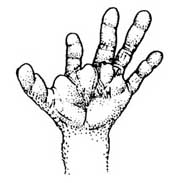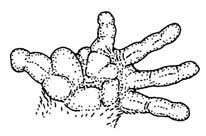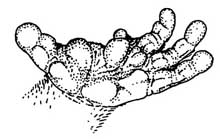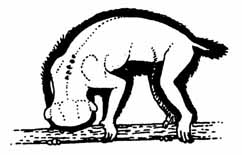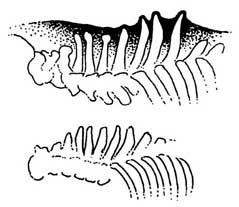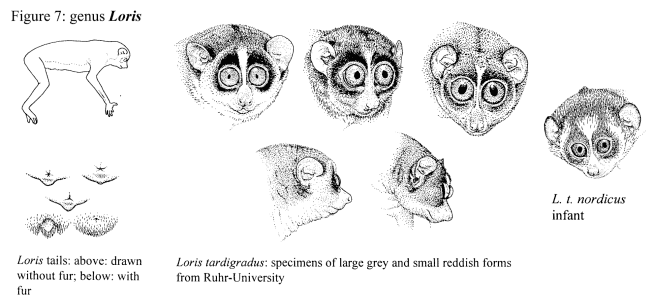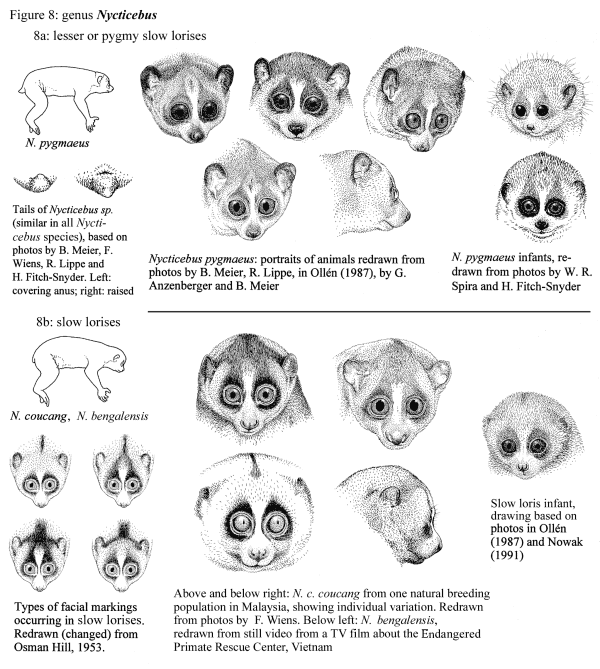| 1) | Second
digit of hand short, but well-developed as in figs.1 and
2, fingers without
interdigital webbing:
|
Asia,
lorises
Continue under 4
|
||||
| Second digit of hand reduced to a nailless tubercle or absent, some interdigital webbing (fig. 3, 4): |
Africa,
pottos
Continue under 2 |
|||||
| 2) | Africa,
pottos:
Very small hand, second digit completely reduced, rays 3-5 partly connected by digital webbing (fig. 3), tail absent or vestigial (about 8-15 mm), long muzzle as shown in fig. 9: |
|
Genus Arctocebus Key to species in preparation |
|||
| More robust hand, second ray reduced to a small nailless tubercle, rays 3-5 partly connected by interdigital webbing (fig. 4), tail length 38 cm – 300 mm, face as in fig. 10: |
|
Continue
under 3
|
||||
| 3) | Vertebral spines in the nuchal region protruding through the skin (fig. 5, fig. 6 above), covered with fur mixed with longer hair; face without distinct markings such as a white median stripe, tail length 3.7-10.2 cm (Nowak, Paradiso 1983; Sanderson 1940) |
Genus
Perodicticus
Key to subspecies in preparation |
||||
| Tail long (in the type specimen longer than 10 cm in spite of missing distal vertebra(e), but probably still within the range valid for Perodicticus; vertebral spines shorter than in Perodicticus, see fig. 6 below (n = 1 skeleton, soft tissue not preserved, but live specimens had been mistaken for Perodicticus) (Schwartz, 1996) |
Proposed
genus
Pseudopotto
|
|||||
|
... | |||||
| 4) | Asian
lorises:
Adult head-body-length usually 18-26 cm, adult weight about 100-350 g, depending on subspecies; slender limbs (see below, fig. 7) and fingers (fig. 1); tail vestigial or absent as shown in fig. 7; facial appearance variable (see fig. 7) Genus Loris. |
|||||
| Adult head-body-length
usually about 18-38 cm, weight about 230-2000 g (may be
less in starved
young captive-reared animals), limbs more robust and
more thickly furred
(below: fig. 8 a, b), hands robust
as in fig. 2 or,
if slender as in fig. 1, then with dark pigmentation.
Tail short, but well-developed
(see below, fig. 8)
Genus Nycticebus. |
||||||
| 5) | Reported head-body-length 18-29 cm, weight about 230-800 g (less in some starved young captive-reared animals), hair fine, silky. Ear rims, fingers and toes with dark pigmentation. Appearance as in fig. 8 a |
Lesser
or pygmy slow
lorises
N. pygmaeus (proposed new species included) |
||||
| Reported head-body-length 26.5-38 cm (no measurements available for small island forms), weight about 265-2000 g, hair coarse. Pigmentation of skin variable. Appearance as in fig. 8 b: |
Slow
lorises
N. coucang, N. bengalensis and in the future previously N. javanicus Key to subspecies in preparation |
|||||
